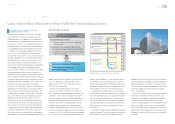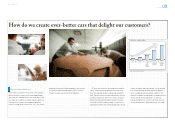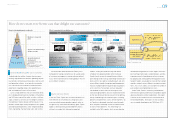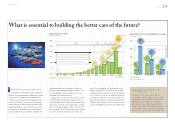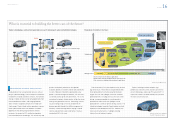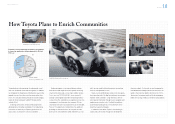Toyota 2013 Annual Report Download - page 10
Download and view the complete annual report
Please find page 10 of the 2013 Toyota annual report below. You can navigate through the pages in the report by either clicking on the pages listed below, or by using the keyword search tool below to find specific information within the annual report.
How do we create ever-better cars that delight our customers?
Toyota Global Vision President’s Message Launching a New Structure Special Feature Review of Operations
Consolidated Performance
Highlights
Management and
Corporate Information Investor InformationFinancial Section
Page 10
NextPrev
ContentsSearchPrint
ANNUAL REPORT 2013
Bringing out our true competitiveness
Toyota has been selling automobiles around the world
ever since the fi
rst Crown was exported to the United
States in 1957. Today, Toyota vehicles are driven in
more than 170 countries and regions. In line with our
policy of producing where there is demand, since the
early 1980s Toyota has progressively increased its car
production in countries where its vehicles are sold. From
2001 onward, Toyota expanded production outside
Japan in accordance with sharp growth in sales, and in
2007 its overseas production exceeded its production in
Japan for the fi rst time. Toyota now has 51 manufactur-
ing bases in 26 countries and regions. Having learned a
great deal from the recent global fi nancial crisis,
however, Toyota has now begun to transition to a
sustainable growth model, shifting its focus away from
volume-driven growth.
We believe that sustainable growth can only be
achieved by focusing on areas where we are truly
competitive over the longer term, both inside and
outside Japan. In Japan, for example, because of its
long history in the country, Toyota has a robust manu-
facturing foundation replete with advanced technolo-
gies, manufacturing expertise, talented human
resources, and a multilayered supply network. It is this
foundation that has supported Toyota’s global ambi-
tions. Japan is and always will be central to the
Company’s ability to make competitive cars and create
innovative manufacturing technologies. To be truly
competitive, we think it is crucial to further increase
Japan’s competitiveness as a global base. Toyota has
been producing three million cars annually in Japan for
more than 30 years, and this production structure has
laid the foundation of the manufacturing competitiveness of
the Toyota Group, including its network of suppliers.
Continuing to concentrate investments in
growth areas
With further growth in sales volume likely, Toyota is
working hard to improve productivity. We are placing top
priority on maximizing capacity utilization and making
effective use of our existing plants and manufacturing
facilities from a global perspective. Over the next three
years we plan to concentrate on modernizing existing
facilities rather than building new plants (excluding those
for which construction is already planned or in progress).
We will continue to make capital investments that are
necessary to sustain growth, and will focus on investing
more effi ciently. Toyota has made signifi cant progress
toward its goal of reducing the basic unit of capital
invested in model redesigns by 40% compared to the
levels seen before the global fi nancial crisis. While keep-
ing total investment at an optimal level, Toyota will
continue its policy of concentrating investment in regions
that are expected to grow—particularly in emerging
markets, where we will step up investments substantially.
Competitiveness cannot be created overnight, nor
should it be regarded as a measurement derived from
short-term profi ts and costs, which fl uctuate depending
on prevailing business conditions. Competitiveness is a
multifaceted challenge that cannot be measured with
data or numbers; it is the sum of countless factors, such
as a company’s ability to nurture human resources, a
corporate culture that pursues greater productivity
through better quality and shorter lead times, the ability
to innovate, and marketing skills, including after-sales
services. The current degree of our competitiveness
varies by country and region. Looking at the situation
from both the medium- and long-term perspectives,
Toyota is poised to refi ne and improve its competitive-
ness. We have put in place groupwide systems that will
enable us to continue making ever-better cars that are
profi table and excel in quality.
INSIGHT The QC team’s job is to deliver zero defects
Making Ever-Better Cars [4 of 10] Enriching Lives of Communities Stable Base of Business






